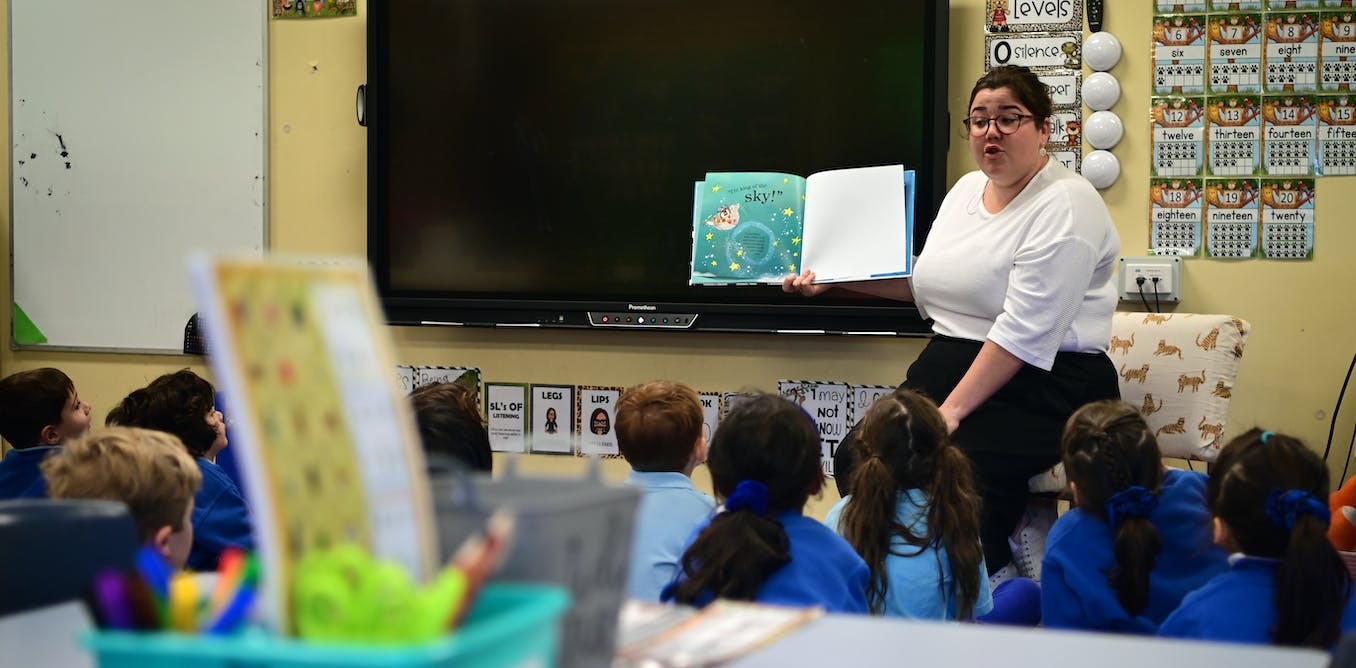When you send your child to school, you expect they will learn how to read. But according to 2023 NAPLAN results, about one-third of Australian school students can’t read at their grade level.
For Indigenous students, students from disadvantaged families, and students in regional and rural areas, it’s more than half.
This is deeply troubling. When children do not learn to read fluently and efficiently in early primary school, it can undermine their future learning across all subject areas, harm their self-esteem, and limit their life chances.
Our new Grattan Institute report, The Reading Guarantee, outlines a strategy to ensure at least 90% of Australian school students are proficient readers.
This includes measures such as more support for lower-performing schools, coaching and building teachers’ expertise. On top of these, a key part of the strategy is that all schools regularly assess students’ reading progress and provide additional catch-up support – either in small groups or one-on-one – to those who are falling behind.
When do kids learn to read? How do you know if your child is falling behind?
Struggling students need early support
As previous Grattan Institute research shows, struggling students need early support so they do not fall even further behind.
Developing foundational reading skills, like decoding (the ability to sound out unfamiliar words on a page), are vital for students’ later reading success. A 2014 study of more than 400,000 students in Years 1, 2, and 3 found if a students’ decoding and vocabulary skills developed normally, fewer than 1% of students had problems with reading comprehension later on.
A focus on these early reading sub-skills is also more likely to instil a love of reading in students.
If students don’t master reading in early primary school, they may struggle with the reading demands of subjects such as biology and history in high school.
Tests can help
The earlier we assess students’ reading skills, the better, so struggling students can be supported to catch-up. For example, a 2017 US study of nearly 200 students found Year 1 and Year 2 students receiving additional help to catch up on their word reading progressed twice as fast as students who didn’t receive this help until Year 3.
The choice of assessment matters too – they need to be quick to administer and give teachers useful information. They should tell teachers what specific areas of reading students are struggling in, so support can be well targeted.
One example of this is The University of Oregon-developed DIBELS (the Dynamic Indicators of Basic Early Literacy Skills). This has six short assessments of about one minute each of different reading sub-skills, such as “phonemic awareness” (identifying speech sounds in spoken language) and “reading fluency” (how quickly and accurately a child reads with the right expression). It also has benchmarks for the beginning, middle and end of the year.
Most Australian state and territory education departments mandate some specific early reading assessment tools and make recommendations about other assessments to use. But our report argues they are not necessarily recommending effective tests and they do not always provide the information teachers need to monitor reading progress.
Some kids with reading difficulties can also have reading anxiety – what can parents do?
We need a national Year 1 Phonics Screening check
There should be a nationally consistent Year 1 Phonics Screening Check to provide governments with a useful “health check” on early reading performance across states. The test was developed in the United Kingdom where it has been mandated for government schools since 2012.
It is also currently mandated in Tasmania, New South Wales and South Australia.
Phonics is not the only important reading skill students should master in early primary school. But having a test focusing on phonics acknowledges how the ability to accurately decode words is a good predictor of students’ future reading achievement.
This test assesses students’ decoding skills across 40 real and made-up words (such as “lig”) of increasing complexity. It takes about seven minutes to complete per student. By assessing 40 words, it can identify the letter-sound combinations a student is struggling with.
Parents would then get a report on their child’s results and aggregate results would also be published at the state and sector levels.
We should also be assessing students at other times
The Year 1 Phonics Screening Check will tell governments how students are tracking on phonics. But schools should also be regularly tracking students’ progress on reading.
Governments should require all schools to assess students’ reading skills (using robust assessments such as DIBELS) at least twice a year from the first year of school to Year 2 and on entry into high school. This would identify students who may not have learnt necessary reading skills in primary school.
Governments should also provide clearer guidelines about which assessment tools are effective. And they should provide guidance on when assessments should be done and advice on what to do with the results.
The alternative is we keep going with a “wait-to-fail” approach, which lets too many students fall through the cracks.




